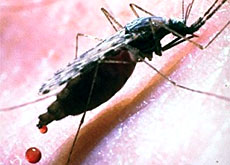
Anopheles gambiae – the malaria machine

Head down, body at an angle, hind legs raised. This is not an advanced yoga class but the distinct posture of the anopheles mosquito when resting or biting.
Experts call it the malaria machine and the more one learns about anopheles gambiae, it is easy to see why.
It breeds prolifically, it feeds on man, and infected females have a good chance of surviving long enough for the parasite to mature.
There are about 2,500 species of mosquito in the world but only those of the genus anopheles carry the human malaria parasite.
Of the 380 known species of anopheles, about 60 can transmit malaria. And of these 60, anopheles gambiae is best adapted to spreading the disease.
“In tropical Africa, the anopheles gambiae vector is so efficient it can breed in the rainy season in a footprint on a roadside,” says Canadian epidemiologist, Don deSavigny, currently based at the Swiss Tropical Institute (STI) in Basel.
Personal habits
Mosquitoes worldwide differ greatly in behaviour. They may be active by day or by night and prefer running or standing water.
Some species like to bite humans while others are fond of animals. Some bite around the ankles, others on the arms.
There are those which inhabit houses or at least eat indoors. Others live outside and prefer to feed there.
With their dark-spotted or dappled wings, the mosquitoes that spread malaria are secretive and nocturnal. They shelter in shaded, humid places during the day and feed at night while people are sleeping.
They fly more quietly and bite more subtly than many other species.
Meal time
A mosquito’s principal food is nectar or a similar sugar source. Females have to suck blood so that they can reproduce. Acquiring protein is essential for egg production.
The mosquito repeatedly pierces the victim’s skin with her mouthpiece – a pair of sharp, needle-like tubes.
With each prick, one tube sends anti-coagulants and other chemicals into the bloodstream so your blood flows freely into her stomach.
When she hits a capillary, the other tube sucks up the blood. An engorged mosquito can triple in weight.
The malaria parasite, plasmodium, enters the human body through the mosquito’s saliva. When another mosquito bites you, it in turn sucks up infected red blood cells.
The parasite needs to develop in the mosquito for at least eight to ten days before it can infect other people again and this is where the warm, wet conditions of tropical Africa play a decisive role.
“Because mosquitoes are a cold blooded animal, the speed at which this development takes place directly depends on the temperature,” says STI project leader, Christian Lengeler.
“If the temperature drops too low, as happens for example when you move up in altitude, then the mosquito will die before the development is completed which means transmission is impossible.”
Mosquito control
After a mosquito has sucked blood and filled her stomach, she rests on a wall.
If it has been sprayed with DDT or a residual insecticide, a few particles adhere to the hairs of the mosquito legs. They will eventually be absorbed within the body and kill the insect.
Since the development of plasmodium in the mosquito takes at least a week, and since the mosquito needs a blood meal every two or three days, the chances are high that a mosquito will be killed before it can infect other human beings.
If all houses have their inner walls sprayed with insecticide, transmission of malaria can be stopped and no new infections will occur.
“Even though you have mosquitoes, there is no malaria transmission if the mosquito can’t live long enough,” says deSavigny.
“That’s also where the insecticide treated net comes in. It acts as that barrier. Even though the mosquitoes are there and they may be infected, they may not succeed in transmitting malaria because we can interrupt the contact between mosquitoes and people.”
swissinfo, Vincent Landon
From egg to adult anopheles takes seven to 21 days, depending on temperature.
The female needs a blood meal for each batch of eggs.
She lays about 100 eggs in water at two or three day intervals.
Eggs take two to three days to hatch.
Larvae grow rapidly, passing through three moults in three days.
After the third moult, the larva becomes a pupa.
After two to three days, the adult emerges.
Mating is the first activity of the newly-hatched adult.
The female mates only once, storing sperm for all subsequent egg production.

In compliance with the JTI standards
More: SWI swissinfo.ch certified by the Journalism Trust Initiative



























You can find an overview of ongoing debates with our journalists here . Please join us!
If you want to start a conversation about a topic raised in this article or want to report factual errors, email us at english@swissinfo.ch.